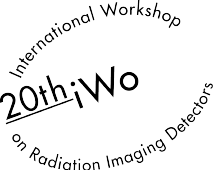Speaker
Description
Currently, there are three trends in the design of human Positron Emission Tomograph (PET) scanners. The conventional ones are based on detector rings of about 70 cm transaxial Field Of View (FOV) and about 20 cm axial FOV. The other two approaches in the research arena are the newest total body PET that aims at completely exploring the subject with 200 cm axial length, or the use of less-bulky and cost-effective, organ-dedicated systems. Cylindrical PET geometries in the XY plane favor the system design, providing an optimal performance as in the case of sensitivity. However, most suitable geometries for dedicated PET scanners exhibited a limited angular tomography that varies depending on the organ and application. That supposes a handicap, since the sensitivity is reduced and the lost of information in the opening axis causes serious artifacts. One way to overcome these artifacts is to use the annihilation photons Time Of Flight (TOF) information in the image reconstruction process. This allows reducing the uncertainty in the emission probability of the voxels in the corresponding Lines Of Responses (LORs).
Our group has a large experience working in the development of dedicated PET systems. Recently, two novel PET scanners have been developed with open geometries: breast- and prostate-dedicated (see figure 1). The breast-dedicated system comprises two detector rings of twelve modules with a field of view of 170mm x 170mm x 94mm [1]. Each module consists of a continuous trapezoidal LYSO crystal and a PSPMT. The system has the capability to vary the rings opening to 60 mm in order to allow the insertion of a needle to perform a biopsy procedure. The prostate system has an open geometry consisting on two parallel plates separated 28 cm. One panel includes 18 detectors organized in 6x3 matrix while the second one comprises 6 detectors organized in a 3x2 matrix. All the detectors consist in a continuous LYSO crystal of 50mm x 50mm x15mm and a SiPM array of 12x12 individual photo-detectors. The system geometry is asymmetric maximizing the sensitivity of the system at the prostate location, located at about 2/3 from the abdomen-anus distance.
In this work we present a TOF resolution study for open geometries. With this aim, our dedicated systems have been simulated using different TOF resolution in order to determine the image quality improvements obtained with the existing TOF electronics in the market. The images have been reconstructed using a modification of the TOR projector with LMOS algorithm [2] which includes the TOF modeling in the calculation of voxel-LOR emission probabilities [3].
Figure 1. Open geometries scanners developed.
References:
[1] L. Moliner et al. “Performance characteristics of the MAMMOCARE PET system based on NEMA standard”, JINST Vol 12, 2017
[2] L. Moliner, at al. “Implementation and analysis of list mode algorithm using tubes of response on a dedicated brain and breast PET” NIMA, Vol. 702, 129-132 (2013)
[3] Spanoudaki VC, Levin⋆ CS. Photo-Detectors for Time of Flight Positron Emission Tomography (ToF-PET). Sensors (Basel, Switzerland). 2010;10(11):10484-10505. doi:10.3390/s101110484.
